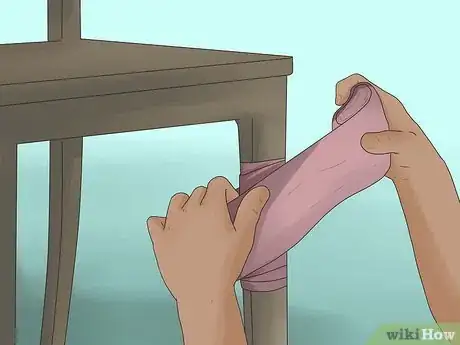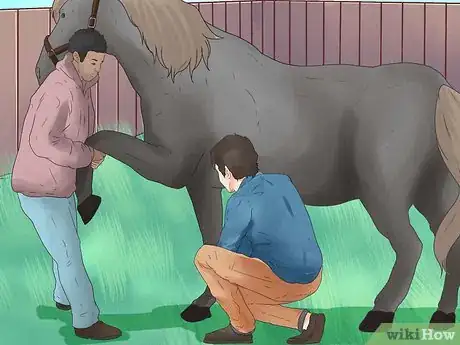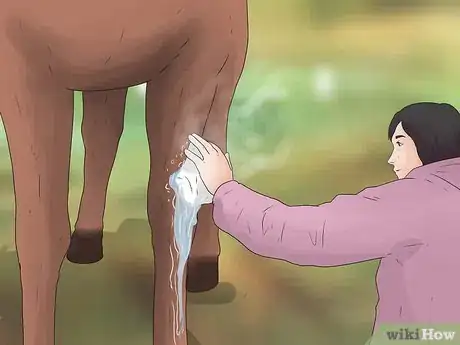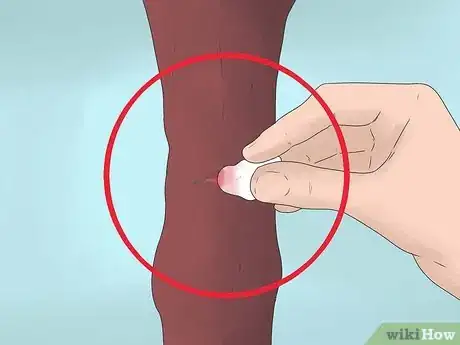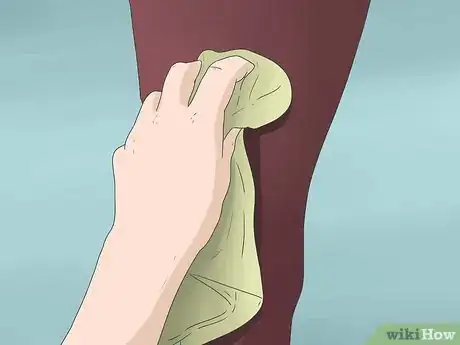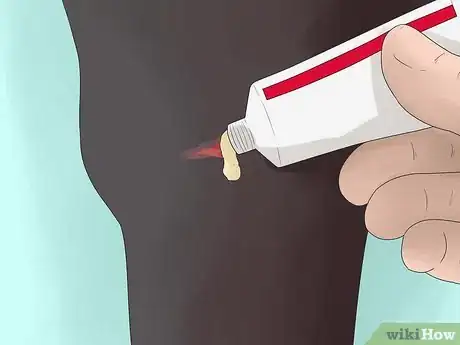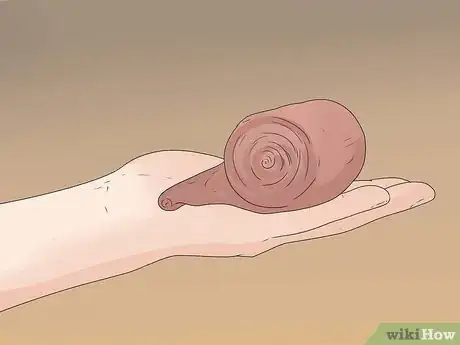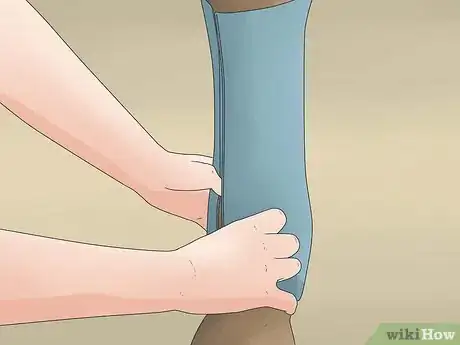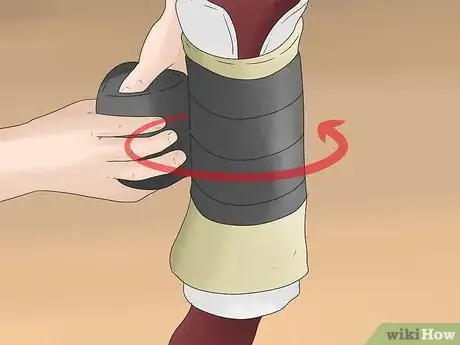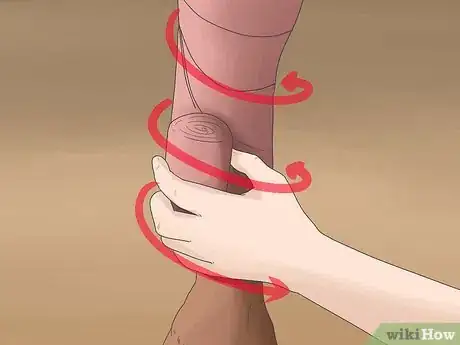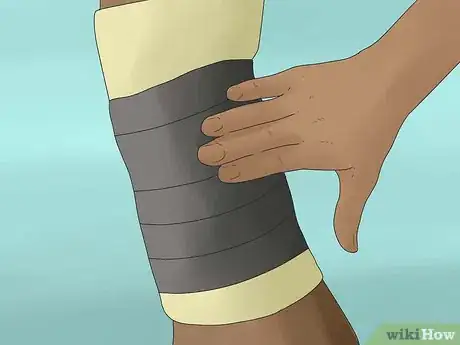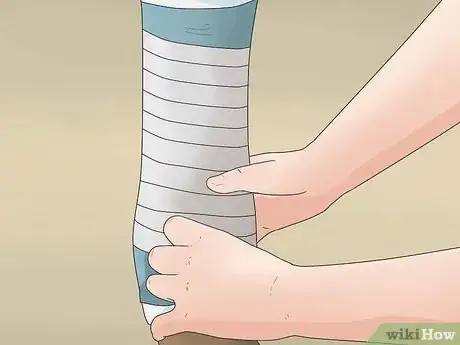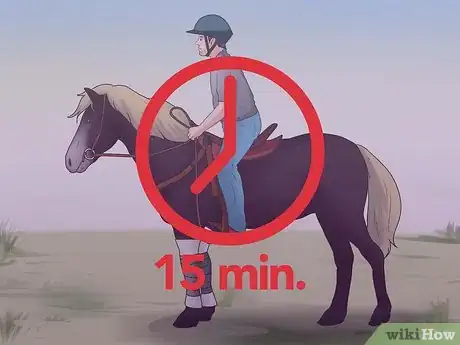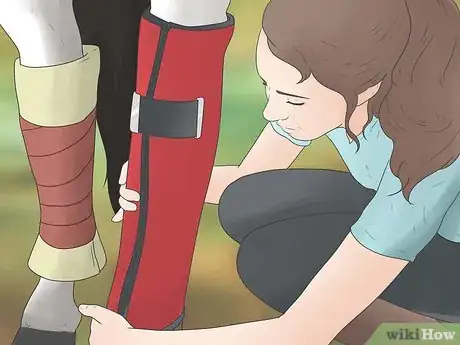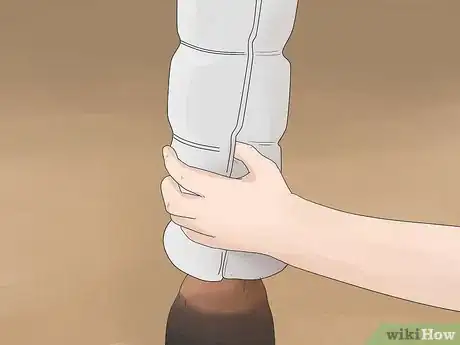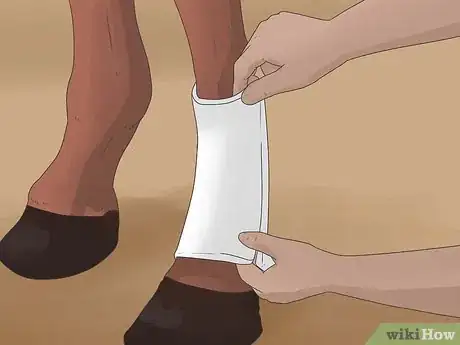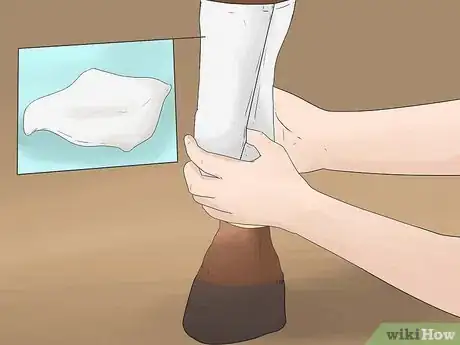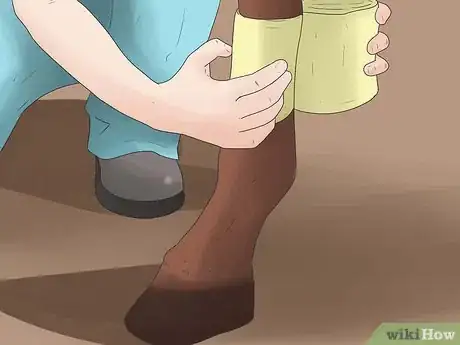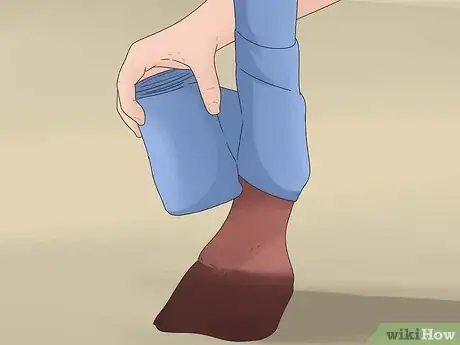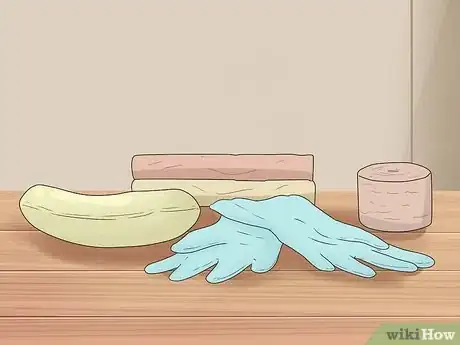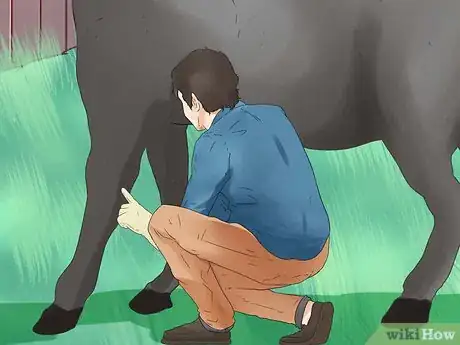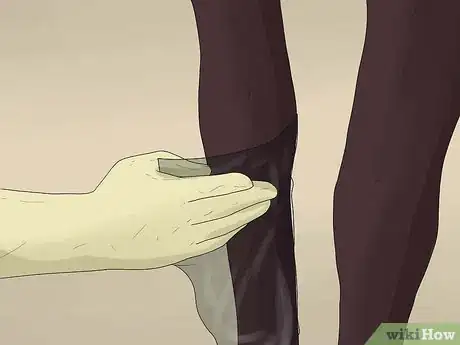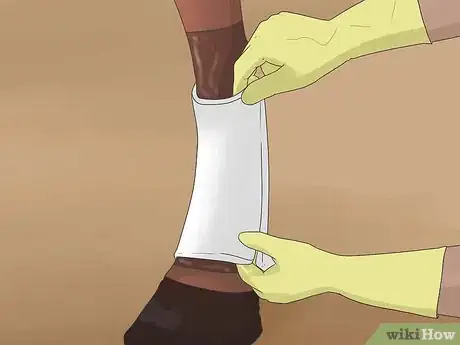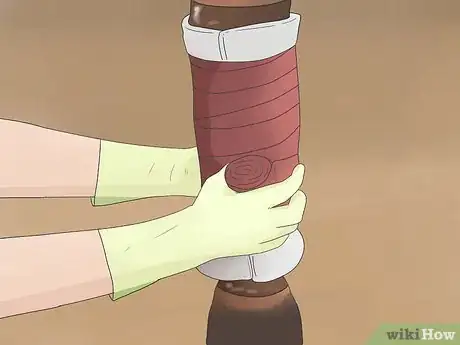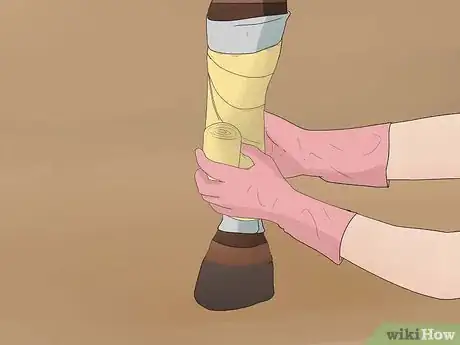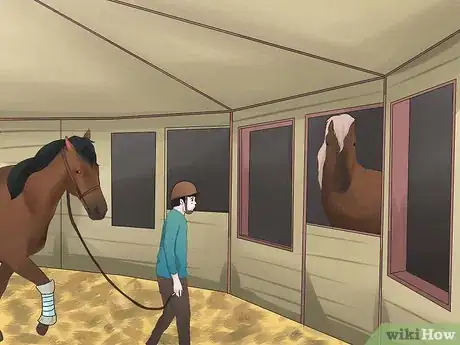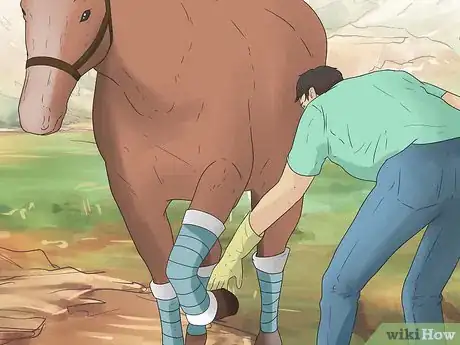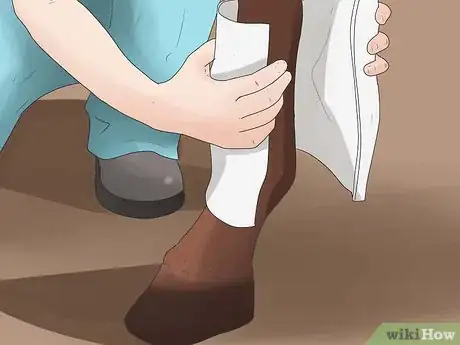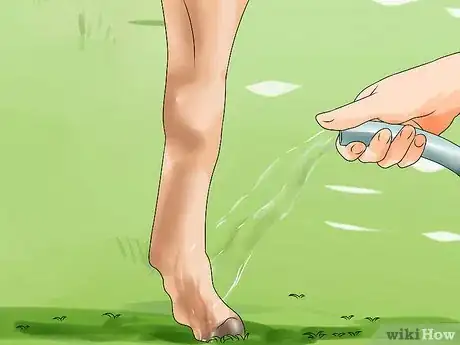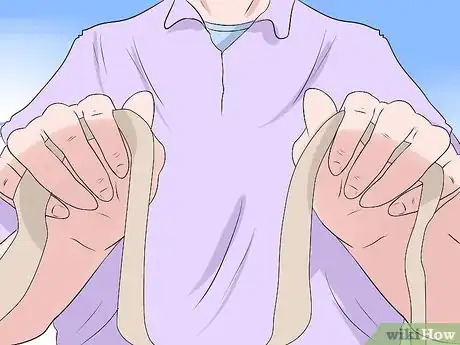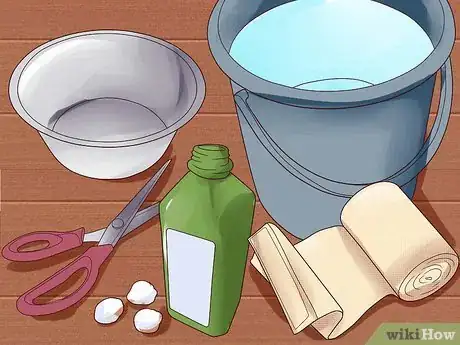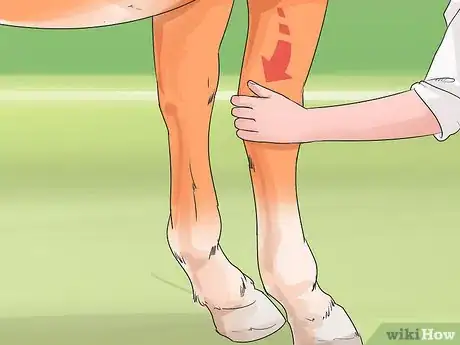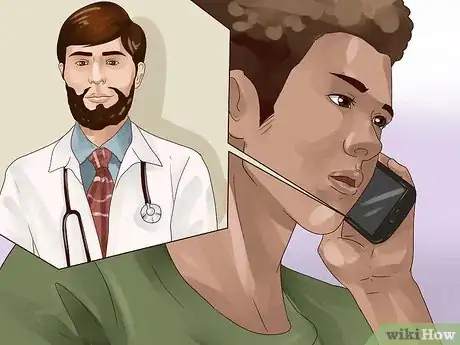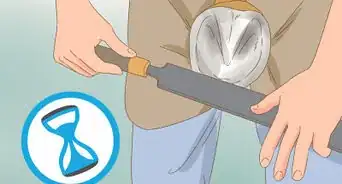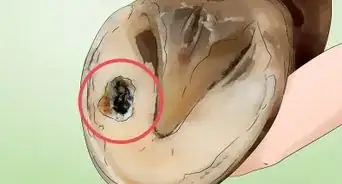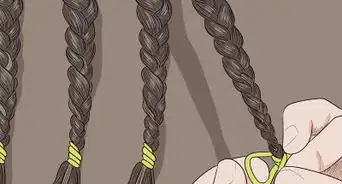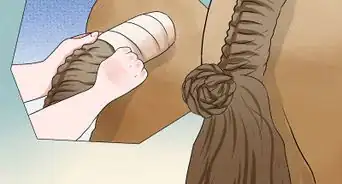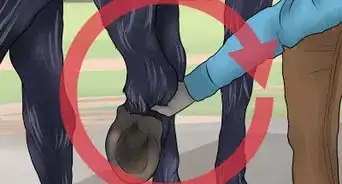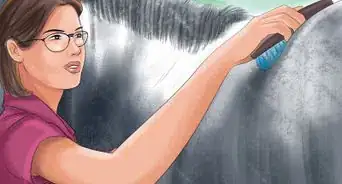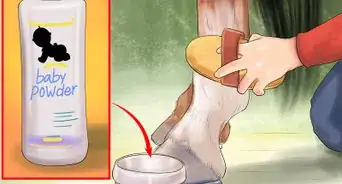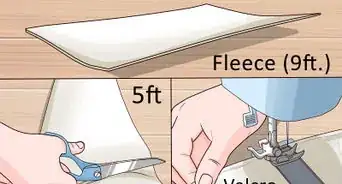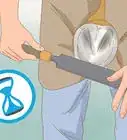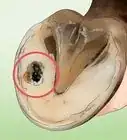This article was co-authored by Ryan Corrigan, LVT, VTS-EVN. Ryan Corrigan is a Licensed Veterinary Technician in California. She received her Bachelor of Science in Veterinary Technology from Purdue University in 2010. She is also a Member of the Academy of Equine Veterinary Nursing Technicians since 2011.
There are 15 references cited in this article, which can be found at the bottom of the page.
This article has been viewed 33,847 times.
Bandage your horse’s leg to provide protection and support while she is working, resting, or recovering from an injury. Large animal veterinarians recommend wrapping a horse’s leg to provide support for her tendons, to reduce swelling, and to protect her from further injury.[1] The process isn't too complicated, but it's important to get it right.
Steps
Preparing to Bandage the Leg
-
1Select the right type of bandage for your horse. Your horse will need different bandages for riding and for standing in the barn. Make sure your bandage is at least 2” wide. If your horse is very large, you may need a wider bandage. Stretchy bandaging makes wrapping the bandage easier and allows your horse some flexibility.[2] [3]
- Have a variety of bandages available. Fleece, flannel, cotton, and self-adhesive bandages are all available. Your horse may prefer certain bandages over others.
- Your vet may also recommend when to use what type of bandage.
-
2Watch a veterinarian bandage a leg first. It’s crucial that you not skip this step! Improperly applied bandages can cause serious injury to your horse.[4]
- Wrapping a horse's leg isn't difficult if you know how to do it, but it can be dangerous if not done properly.
- Ask a veterinarian or experienced equine professional to supervise your first attempts at bandaging.
- Make sure you understand how to apply equal pressure for the entire length of the bandage. If one part of the bandage is looser than the rest, it will cause "bandage bow," which is a type of tendon damage.
Advertisement -
3Practice by wrapping the bandage around a chair leg.[5] Make sure that you are able to bandage a chair leg correctly before you try on your horse.
- Consider practicing on the leg of a willing human volunteer instead.
-
4Ask an experienced friend to hold the horse’s leg the first time. Wrapping a bandage can sometimes be a two-person job even for professionals. Make sure you have someone to help you your first few times.
- Having another person will also help keep your horse calm.
- Never wrap a horse’s leg without knowing how to do it properly!
-
5
-
6Clean any open wounds on the leg. Ask a veterinarian to demonstrate the proper technique. Always make sure a wound is cleaned, rinsed, dried, and dressed before bandaging.[8]
- You can usually use “tamed iodine” (betadine) or chlorhexidine scrub to clean wounds. Before you use it, dilute the "tamed iodine" with water according to the instructions on the label to ensure it's safe for use on your horse. Consult with your vet to see what solution is best for your horse.[9]
- Ask a veterinarian for help with deep wounds.
- Don’t wrap your horse’s leg if s/he has a leg injury that has not been properly treated.
-
7Make sure the leg is dry. Leaving the skin damp can cause irritation. If your horse has a wound, a damp leg will also prevent healing. Use a soft, clean cloth to dry the leg.[10]
- Brush the horse’s leg. Smooth down the hair on the horse’s leg until it lies flat.
-
8Apply antibiotic to a wounded leg. If you’re bandaging a wound, apply a topical antibiotic ointment, such as silver sulfadiazine or triple antibiotic cream.[11]
- Consult with your vet before applying ointment. Your vet may have specific recommendations depending on the situation.
- Apply a non-stick sterile pad over the wound before you apply the reusable bandage.
Wrapping a Basic Bandage
-
1Select the correct bandage. Choose a strong bandage, such as a quilt bandage or a polo bandage with Velcro. Make sure it’s clean.
- Stretchy bandaging can be helpful, but make sure that you don’t pull it too tight as you wrap.
-
2
-
3Wrap your horse’s leg from the inside around the front of the leg. Wrap clockwise on the right legs and counterclockwise on the left legs.
- Don’t wrap the bandage too tightly. This can cause pressure points or injury to your horse’s tendons.
- Don’t wrap the bandage too loosely. Loose bandages may fall off or cause your horse to get tangled up.
- Don’t place the bandage over joints. If your horse has an injury near its joint, ask your vet to show you how to properly wrap the leg. They will instruct you on how to cut the bandage to accommodate the joint. If your vet hasn't shown you how to wrap your horse's joint, don't do it on your own. You could hurt your horse.
-
4Wrap in a spiral pattern. Start by wrapping the leg top to bottom. Then wrap up the leg, covering the first bandages.
- Overlap each wrap of the bandage by about half.
-
5Apply smooth, uniform pressure. Exert just enough pull to stretch the fabric to half its maximum extended length.
- Check your bandaging a few times as you wrap. You should be able to get two fingers under the bottom of the bandage and one under the top.
- Don’t leave any lumps or ridges underneath the bandage.
-
6Secure the wrap. An adhesive bandage can be helpful if dirt or debris tends to get underneath. You can also use bandage pins.[14]
- Secure the wrap with masking tape or duct tape if needed. This can be helpful for bandages that will stay on for a while, such as standing or shipping bandages.
- Apply the tape once around the top of the bandage and once around the bottom of the bandage.
-
7Check to make sure that you bandaged the leg properly. Wait at least 15 minutes after bandaging the leg before doing the following:
- Leaving the horse in the stall.
- Riding.
- Grazing.
Applying Shipping Wraps
-
1Apply shipping wraps to protect your horse’s legs while traveling. Shipping wraps can help protect your horse’s legs from injury while the horse is traveling.
- You may prefer to use shipping boots, especially if someone else is shipping your horse. Shipping boots go from the hock down to the hoof and provide extra protection.
-
2Wrap leg pads around the horse’s legs. Commercial quilted wraps are available, or you can use regular cotton to wrap a layer at least 1” thick. Thick padding offers your horse protection from bumps and injury.[15]
- Soft materials are good because the shipping wraps will be on the horse for a while, and you don’t want your horse’s skin to get irritated.
- Apply the padding so that it is even and flat. Avoid large wrinkles or uneven layers.
- Make sure that the padding extends below the coronary band of the hoof. This is the small “ridge” that goes along the upper border of the hoof.[16] [17]
-
3Wrap bandages around the pad. Flannel bandages about 6” wide are excellent for creating a shipping wrap.[18] Fleece polo wraps are also a good choice. Look for bandages that are slightly stretchy.
-
4Start wrapping at the inside of the cannon bone. This will be roughly just under the horse’s knee. Wrap the bandage in the same direction as the padding. This will help you avoid putting too much pressure on the tendons. Wrap the bandage downward, overlapping by about half the width each time.
- Use moderate tension when wrapping. You don’t want the wrap to be too tight, but you also don’t want it to loosen or fall off in transit. Your horse could trip or get tangled in loose bandages.
- Check for the appropriate tension by slipping your finger beneath the bandage. You should be able to get your finger in between the bandage and your horse’s leg without too much effort.
-
5Cover the horse’s lower leg. A shipping bandage will help protect your horse’s lower leg if it is applied correctly. It should cover the heels, coronary band, and lower leg.
- Make sure you wrap the bandage over the bulbs of your horse’s heels. This way, the bandage will not “ride up” during the trip.
-
6Wrap the bandage back up the leg. Following the same spiral motion, wrap the bandage back up the leg to just below the knee.
-
7Secure the bandage. Fasten the bandage with crossed bandage pins. For extra protection, wrap masking tape in a downward spiral around the leg.
Applying Riding/Polo Wraps
-
1Apply riding wraps to provide additional support. When horses are training to jump or spin, they may injure their legs. Wrapping your horse’s legs with riding wraps can support its ligaments and tendons and protect your horse from injury.[19]
- Wash these wraps frequently. They can get dirty or unraveled.
-
2Wrap a thin cotton sheet around your horse’s leg. Hold it in place with one hand, or have someone help you by holding it in place.
- It’s important to use a thin cotton lining between your horse’s leg and the wrap. This will help protect your horse’s skin.
-
3Start wrapping just under your horse’s knee. Begin at the inside of the leg and wrap to the outside. Wrap clockwise for the right leg, and counterclockwise for the left leg. Wrap down the horse’s leg in a spiral pattern.[20]
- Use a self-adhesive bandage or polo wrap to make this process easier.
- Use the techniques in Method 2 for proper bandaging.
-
4Wrap under the fetlock. Use slightly more tension as you wrap the horse’s fetlock. Bring the bandage back up around the leg. Wrap around the fetlock twice more.[21]
-
5Wrap the bandage back up the leg. Wrap up the leg in a spiral pattern. Decrease the tension as you reach the top of the bandaging.[22]
Applying Sweat Bandaging
-
1Consult with your veterinarian. When horses experience strain, sprain, or other traumatic injury in their legs, their legs can swell. The leg may become inflamed and warm to the touch. In these cases, vets may prescribe a “sweat” bandage to help reduce fluid build-up and inflammation in your horse’s leg.[23]
- Do not apply a sweat bandage to recent or open wounds
-
2Purchase or prepare a “sweating” poultice. Always wear gloves when handling or applying a poultice. Your veterinarian may recommend a particular poultice. You can purchase commercial sweating preparations or make your own. Ask your vet for suggestions if you choose to make your own. Common ingredients include:[24]
- Epsom salts
- DMSO (dimethylsulfoxide)
- Nitrofurazone ointment
- Mineral oil
- Petroleum jelly
- Glycerin or glycerol
-
3Gather the other materials. In addition to your sweating poultice, you will need to gather the following items:
- Soap and water
- A towel
- Rubber gloves
- Lightweight plastic wrap (e.g., kitchen cling wrap, packing wrap)
- Sheet cotton, roll cotton, or leg quilts
- Bandages
- Stretch adhesive tape
-
4Clean and dry the leg. It is essential that you thoroughly clean and completely dry your horse’s leg before applying the sweating poultice.[25]
- Poultices that use DMSO are particularly prone to carrying any substance on the surface of your horse’s body into the wound. Make sure all of your equipment is clean. DMSO can also irritate damp skin, so dry your horse’s leg thoroughly before you apply it.
-
5Check your horse’s leg for injuries. Even microscopic cuts or scratches can become irritated by sweating poultices.[26]
- If your horse has very furry legs, clip the fur in the area where you plan to apply the sweating poultice. Do not shave the leg, as this could nick or scratch it.
-
6
-
7Wrap plastic wrap around the leg. Wrap a thin, even layer of plastic wrap around the poultice. Try to avoid too many wrinkles.[29]
- The plastic will help seal in the heat, producing the “sweat.”
-
8Apply padding. Wrap layers of cotton or leg quilts around the plastic wrap. The padding should be at least an inch thick. Keep the layers smooth and even.[30]
-
9Wrap the bandage around your horse’s leg. Use a support bandage that is at least 2-3” wide.[31] [32]
- Start at the midpoint of the leg and wrap in a spiral pattern.
- Begin at the front and work to the back of the leg. Wrap the bandage counterclockwise for the left leg and clockwise for the right leg.
- Wrap the bandage so that each layer overlaps the previous layer about halfway.
-
10Use even, moderate tension. Do not pull too tightly on the bandage. This could cause further swelling in the leg. Try to keep the padding smooth and even as you wrap.[33]
- Do not wrap the bandage too loosely, either. The fabric of the bandage should stretch about halfway to its maximum extension as you wrap it.
- Check the tightness by placing your finger between the bandage and your horse’s leg. If you can’t slip your finger in between the bandage and the leg easily, you have wrapped the bandages too tightly.
-
11Confine your horse. A horse with a sweat poultice should be confined to its stall or a small run. This will keep your horse from overexercising its leg while it is wrapped.
-
12Monitor your horse’s leg. It’s important to check the bandage several times a day to make sure it is still in place. Check for swelling, irritation or redness in the bandage area.[34]
- If you see swelling around the bandage area, remove the bandage.
- If your horse becomes distressed or upset, irritable, or begins to gnaw or paw at the bandage, check the bandaged area. Consult with your vet.
-
13Remove the sweat bandage after 12 hours. Do not leave a sweat on your horse for longer than 12 hours.[35]
- If you need to apply another sweat, allow the leg to “rest” for 12 hours first. Then reapply the sweat.
-
14Wash your horse’s leg. It’s important to wash away any remaining sweat poultice after you’ve unwrapped the sweat bandage. Usually, water will do, but you can also use a a small amount of a mild shampoo.[36]
Tending the Bandages
-
1Check the bandages daily.[37] You should check your horse’s bandages several times a day. This is especially important if your horse is wounded or you are applying a sweat.
- Make sure that the bandages haven’t fallen off.
- Make sure that the bandages aren’t too tight by checking for swelling above the bandage.
- Watch for blood, pus, or poultice that has seeped through the bandage layers. This is called "strike through." If you notice this, change the bandages immediately.
- Check to make sure that the horse isn’t chewing on the bandages. Discourage chewing by covering the wrap with a foul tasting, non-toxic substance such as roof oil.
-
2Rewrap the leg every one to two days.[38] Changing the bandage is an important step in preventing these problems:
- Poor circulation
- Slipping bandages
- Skin irritation
-
3Examine the leg before reapplying the bandage. You don’t want to rebandage a leg that is not doing well. Look for:
- Swelling
- Heat
- Excessive sweating
- Irritation
-
4Monitor your horse’s overall condition.[39] Consult a veterinarian if your horse exhibits any of these symptoms:
- Lameness
- Temperature
- Loss of appetite
- Depression
- Irritability
References
- ↑ http://www.aaep.org/info/horse-health?publication=773
- ↑ http://www.horsechannel.com/horse-exclusives/horse-polo-wraps.aspx
- ↑ http://www.aaep.org/info/horse-health?publication=773
- ↑ http://vetmed.tamu.edu/news/pet-talk/topical-wound-care-for-horses/#.VScU0UtteqQ
- ↑ http://largeanimal.vethospitals.ufl.edu/services/equine-lameness/
- ↑ http://largeanimal.vethospitals.ufl.edu/services/equine-lameness/
- ↑ http://www.aaep.org/info/horse-health?publication=773
- ↑ http://www.aaep.org/info/horse-health?publication=773
- ↑ http://www.horsechannel.com/horse-health/how-to-bandage-horses-leg.aspx
- ↑ http://www.horsechannel.com/horse-health/how-to-bandage-horses-leg.aspx
- ↑ http://www.horsechannel.com/horse-health/how-to-bandage-horses-leg.aspx
- ↑ http://www.aaep.org/info/horse-health?publication=780
- ↑ http://www.thehorse.com/articles/18918/bandaging-horses
- ↑ http://largeanimal.vethospitals.ufl.edu/services/equine-lameness/
- ↑ http://www.thehorse.com/articles/10036/bandaging-wrapping-it-up
- ↑ http://www.thehorse.com/articles/18918/bandaging-horses
- ↑ https://horses.extension.org/sensitive-structures-of-the-hoof/
- ↑ http://www.thehorse.com/articles/10036/bandaging-wrapping-it-up
- ↑ http://www.aaep.org/info/horse-health?publication=773
- ↑ http://www.horsechannel.com/horse-exclusives/horse-polo-wraps.aspx
- ↑ http://www.horsechannel.com/horse-exclusives/horse-polo-wraps.aspx
- ↑ http://www.horsechannel.com/horse-exclusives/horse-polo-wraps.aspx
- ↑ http://www.aaep.org/info/horse-health?publication=779
- ↑ http://www.aaep.org/info/horse-health?publication=779
- ↑ http://www.proequinegrooms.com/index.php/tips/grooming/the-basics-of-sweating-your-horse-s-leg/
- ↑ http://www.proequinegrooms.com/index.php/tips/grooming/the-basics-of-sweating-your-horse-s-leg/
- ↑ http://www.aaep.org/info/horse-health?publication=779
- ↑ http://www.proequinegrooms.com/index.php/tips/grooming/the-basics-of-sweating-your-horse-s-leg/
- ↑ http://www.aaep.org/info/horse-health?publication=779
- ↑ http://www.aaep.org/info/horse-health?publication=779
- ↑ http://www.aaep.org/info/horse-health?publication=779
- ↑ http://www.thehorse.com/articles/18918/bandaging-horses
- ↑ http://www.aaep.org/info/horse-health?publication=779
- ↑ http://www.aaep.org/info/horse-health?publication=779
- ↑ http://www.aaep.org/info/horse-health?publication=779
- ↑ http://www.proequinegrooms.com/index.php/tips/grooming/the-basics-of-sweating-your-horse-s-leg/
- ↑ http://www.aaep.org/info/horse-health?publication=773
- ↑ http://vetmed.tamu.edu/news/pet-talk/topical-wound-care-for-horses/#.VScU0UtteqQ
- ↑ http://vetmed.tamu.edu/news/pet-talk/topical-wound-care-for-horses/#.VScU0UtteqQ
About This Article
To wrap your horse’s leg, first clean the area with warm water or iodine to make sure no bacteria is trapped inside. Then, wrap it with clean leg pads at least an inch thick to protect the injury. On top of the padding, wrap a strong bandage like quilt or polo. Start at the top and wrap the leg in a spiral pattern, overlaying the bandage by about half its width. Pull the bandage tight but don’t wrap it so tight that it puts pressure on your horse’s leg. Finally, secure the bandage with Velcro, tape, or a bandage pin. For more tips from our Veterinary co-author, including how to apply shipping, riding, and polo wraps to your horse’s leg, read on!


